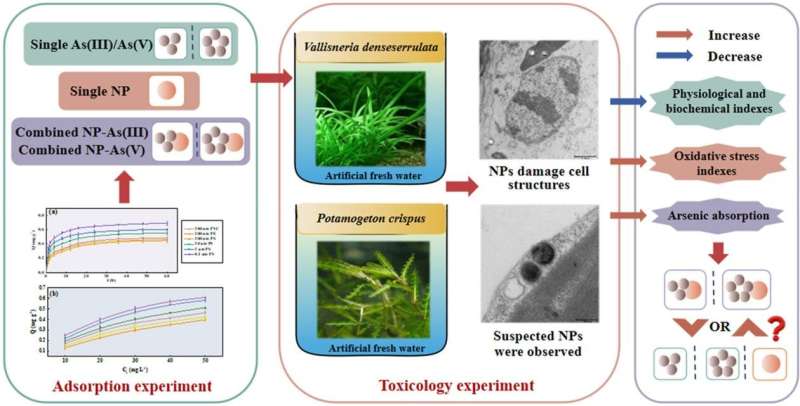Micro- and nano-plastics and arsenic combination intensifies toxic effect on submerged macrophytes

Micro- and nano-plastics (MP(NP)s) in the environment are concerning due to their large specific surface area, low surface polarity, and easy adsorption and accumulation of other pollutants. Submerged macrophytes, which are completely submerged in water, may be more sensitive to changes in pollutants in the aquatic environment than other groups of organisms.
Researchers from the Wuhan Botanical Garden (WBG) of the Chinese Academy of Sciences (CAS) investigated the combined effects of varying types of MPs and arsenic (As (III) and As (V)) on submerged macrophytes.
Adsorption kinetics showed that the adsorption capacity of MP(NP) s for As (III) and As (V) increased rapidly in the first 24 hours and reached the adsorption equilibrium after 36 hours. The adsorption capacity at equilibrium of MP(NP) s increased with the increase of As concentration.
With the increase of the pH value, the adsorption of MP(NP) s on As first increased and then decreased, and the adsorption capacity reached the peak at the pH of six. And the adsorption process was favorable at higher temperatures.
All the results indicated that the adsorption capacity of MP(NP) s for As was positive with the increase of reaction time and concentration, and the adsorption capacity was closely related to pH value and temperature. Polyvinyl chloride (PVC) and polystyrene (PS) containing complex functional groups had a larger adsorption capacity for As than polyethylene (PE), while NPs with smaller particle size showed good adsorption behavior due to their larger specific surface area.
PS-NPs significantly inhibited total chlorophyll, Fv/ Fm, soluble sugar, soluble protein, malondialdehyde, antioxidant enzyme activity and root activity of submerged macrophytes, and damaged the cellular structure of plant leaves (cell membrane, mitochondria and nucleus).
In addition, the growth of submerged macrophytes was more significantly inhibited when PS-NPs and arsenic acted together, rather than reducing arsenic toxicity, further indicating that the adsorption behavior of PS-NPs and arsenic could enhance the ecological risk of pollutants.
This work provides a theoretical basis for further understanding the toxic effects and mechanism of single and combined contamination of PS-NPs and As on submerged macrophytes.
This study titled "The adsorption of arsenic on micro- and nano-plastics intensifies the toxic effect on submerged macrophytes" was published in the Environmental Pollution.
More information: Na Tang et al, The adsorption of arsenic on micro- and nano-plastics intensifies the toxic effect on submerged macrophytes, Environmental Pollution (2022). DOI: 10.1016/j.envpol.2022.119896
Journal information: Environmental Pollution
Provided by Chinese Academy of Sciences





















